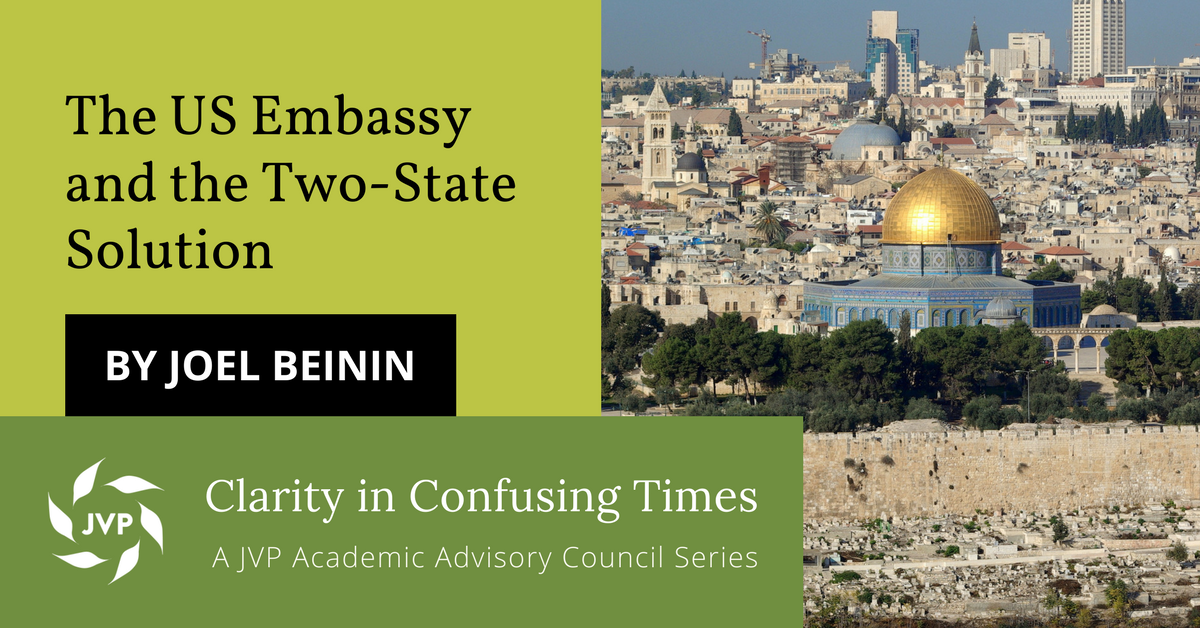We cannot feast while there is famine.
Clarity in Confusing Times: The US Embassy and the Two-State Solution

The Academic Advisory Council is pleased to introduce a new blog series, “Clarity in Confusing Times.” These short blog posts will take on some of the more confusing questions that this administration brings up for our work. The first is by longtime JVP member Joel Beinin, who is the Donald J. McLachlan Professor of History and Professor of Middle East History at Stanford University. Have a question you’d like to see answered here? Contact Academic Program Manager Tallie Ben Daniel at tallie@jvp.org
Recognizing Jerusalem
The United States, Canada, and most European countries have never recognized Israeli sovereignty over Jerusalem. According to the November 1947 UN General Assembly Resolution 181, which outlined a plan to partition Palestine into an Arab state and a Jewish state, Jerusalem and the surrounding area, including Bethlehem, was to be put “under a special international regime and… administered by the United Nations” (a corpus separatum). Israel occupied West Jerusalem during the 1948 Arab-Israeli War (Jordan occupied East Jerusalem and Bethlehem). In 1950, after being admitted to the United Nations, Israel proclaimed Jerusalem its capital. Thirteen countries, mostly Latin American countries, did establish embassies in West Jerusalem, effectively acknowledging it as Israel’s capital. As of 2006, no embassies remain in Jerusalem.
Israel occupied East Jerusalem in the 1967 War. On June 27, Israel applied its domestic laws to East Jerusalem, effectively annexing the city. East Jerusalem and many neighboring villages were incorporated into a vastly expanded Jerusalem Municipality. No country has recognized the legality of these measures or Israel’s subsequent establishment of over a dozen neighborhoods (settlements), which now house over 300,000 Israeli Jews, in and around East Jerusalem.
Palestinians who resided in East Jerusalem when Israel conquered the city were offered Israeli citizenship. Only a very small number accepted it because they were expecting to return to Jordanian rule. Today, most East Jerusalemites are permanent residents of Israel. They have more rights than other West Bankers, but far fewer rights than even Israel’s second class Palestinian Arab citizens. Over the last several decades, Israel has severely restricted Palestinian housing construction in East Jerusalem and implemented policies intended to reduce the Arab population of Jerusalem.
On August 20, 1980, the UN Security Council passed Resolution 478 (by a vote of 14-0 with the U.S. abstaining) which censured Israel for legislation it adopted a month earlier (Basic Law: Jerusalem, Capital of Israel) that declared, “Jerusalem, complete and united, is the capital of Israel.” All the countries that had maintained embassies in Jerusalem subsequently moved them out of the city, mostly to Tel Aviv. Guatemala and El Salvador are currently the only countries that recognize Jerusalem as the capital of Israel.
Why does it matter if the Trump administration moves the US embassy to Jerusalem? How would this affect the possibilities for a two-state solution, if at all?
Moving the U.S. embassy to Jerusalem would mean recognizing it as Israel’s capital, even if the embassy is located in West Jerusalem, where the U.S. does maintain a Consulate. The United States would thereby defy the international consensus on Jerusalem. By adopting Israel’s position on one of the most contentious issues in the Palestinian-Israeli conflict, the U.S. would disqualify itself from playing the role of mediator, which it has appropriated for itself since the 1991 Madrid Conference.
However, moving the embassy would have little practical effect. Secretary of State John Kerry, despite prodigious efforts, failed to find a formula to restart Palestinian-Israeli negotiations in 2013-14. This demonstrated the inability of the United States to play a constructive diplomatic mediating role. In recent years, this has been largely because it has not put meaningful pressure on Israel to cease settlement expansion in East Jerusalem and the West Bank. But more fundamentally, it is because all U.S. administrations since 1967 have considered Israel an important strategic ally.
Should Palestinian-Israeli negotiations resume, they will likely be under international auspices. The January 15 conference hosted by France was an effort to mobilize international support for renewed negotiations to achieve a two-state solution to the conflict: a Palestinian state in the West Bank and Gaza Strip with its capital in East Jerusalem alongside the state of Israel. However, the conference achieved no concrete results. On April 18, 2013, as Secretary Kerry was launching his initiative, he told The Guardian, “the window for a two-state solution is shutting…I think we have some period of time – a year to year-and-a-half to two years, or it’s over.” So, in Secretary Kerry’s estimation, the two-state solution has been dead for two years or more.
Explore Resources
Get
the Wire
Stay up to date on the most important news from Palestine and the Palestine solidarity movement, and receive action alerts and invitations to online events.